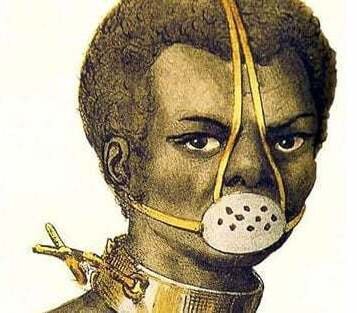Have You Seen Her?: Ex-Slave Used in Protest Signs is Venerated as a Saint

It was ubiquitous as it was disturbing.
The recent image of a white woman holding a protest sign, printed with a muzzled black slave picture next to the caption, “Muzzles are for dogs and slaves. I am a free human being,” scurried its way through all levels of media and culture in a hurry.
Gretha Stenger, in Arcata, California to protest the state’s state-at-home-orders, including calls to wear masks, said the sign was not hers, and that she failed to grasp the depiction’s significance in her haste to accept it. Another woman, Larkin Small, was also photographed holding the sign.
The safe bet to assume would be that whoever used the image for the sign just Googled “slave muzzle” and grabbed the first printable image. Or the most popular, repeated result in the search.
The illustrated woman, forever muzzled, went by the name of Anastacia, an enslaved African in 1700s Brazil. She’s also known as Escara Anastacia, “Anastacia the Enslaved,” a moniker that directly connects her identity with her enslavement. Escara is Portuguese for slave.
The origin of the muzzle varies. One legend has Anastacia’s mistress order the iron spike torture device put on to deform her face and squeeze her neck out of jealously for her husband raping her consistently. Another legend stated the princess was masked, or more appropriately muzzled, for teaching her fellow slaves to worship their native African gods, a story that connects with her reported knowledge of medicinal cures and healing practices.
Anastacia supposedly died of tetanus, also called lockjaw, caused by either the mask or the collar she was forced to wear. Her owner posthumously freed her.
A painting of Anastacia was recovered from the debris of the Church of Rosario in Rio, burnt down in 1967, and the visage has since been irrecoverably linked to the former slave.
In the late nineteenth and early twentieth century, reports arose of black Brazilians reverencing the image of a woman in the sort of punishment mask Anastacia, now a symbol of power and resistance, was subjected to. In time, she became a reverend saint among Brazilian Catholics, in spirit only. In 1987, the Catholic Church denied St. Anastacia ever existed, thus preventing her from sainthood status from the church. This is despite her painting was first discovered in a Catholic church.
.


